Sourdough Panettone
Mon, Dec 17, 2018
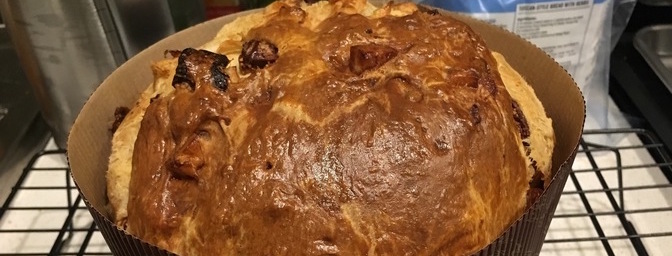
Recipes from this article
I’ve been a fan of panettone for about as long as I’ve been aware of its existence. What’s not to love? A soft, sweet, buttery enriched bread dough studded with candied citrus peel and dried fruits. It’s everything you wish fruitcake was. And yet it always seemed like one of those things that were just inaccessible—”people who make panettone have been working years on their techniques, maybe just leave it to the pros?”
So after felling this way for many years, I happened to find myself watching an episode of The Great British Bake-Off: Masterclass in which Paul Hollywood makes a loaf of panettone. His method was very brioch-y, and I’d made brioche before. Suddenly it seemed so much more like something I could actually do. I ordered some candied peels and paper sleeves right then.
Once they arrived, I spent some time studying Paul’s recipe. Since it used commercial yeast and I wanted to use my sourdhough starter, I compared it with the dough from Maurizio Leo’s cinnamon rolls, my favorite enriched dough using sourdough starter. The proportions were a little different, but the final dough weight was about the same, so I decided to use a fusion of the two. I started with Maurizio’s dough, integrating the fruit during the stretch and fold process, and then fermented it overnight in the fridge and switched to Paul’s method the next day.
So let’s get the bad news out of the way first: this is complicated. It’s not hard per se, but there’s a lot of steps, a lot of equipment, and the whole thing takes place over two days. Below is the account of my first two loaves of panettone and the changes I made between the first and second, but I’ll lead with a link to the recipe as it ended up after the second one:
Sourdough Panettone
A festive, Italian-inspired holiday loaf. This recipe is somewhat involved, but the results are incredible. As of this writing, it’s the best bread I’ve ever made.
This recipe includes figs and candied orange peel, but you can replace the fillings with any mixture of dried fruit and …
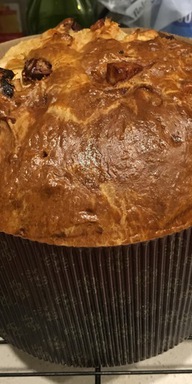
The First Loaf
I began by working together the wet ingredients, adding in the zest of one orange and a teaspoon of vanilla. Then I slowly worked that into the dry team:
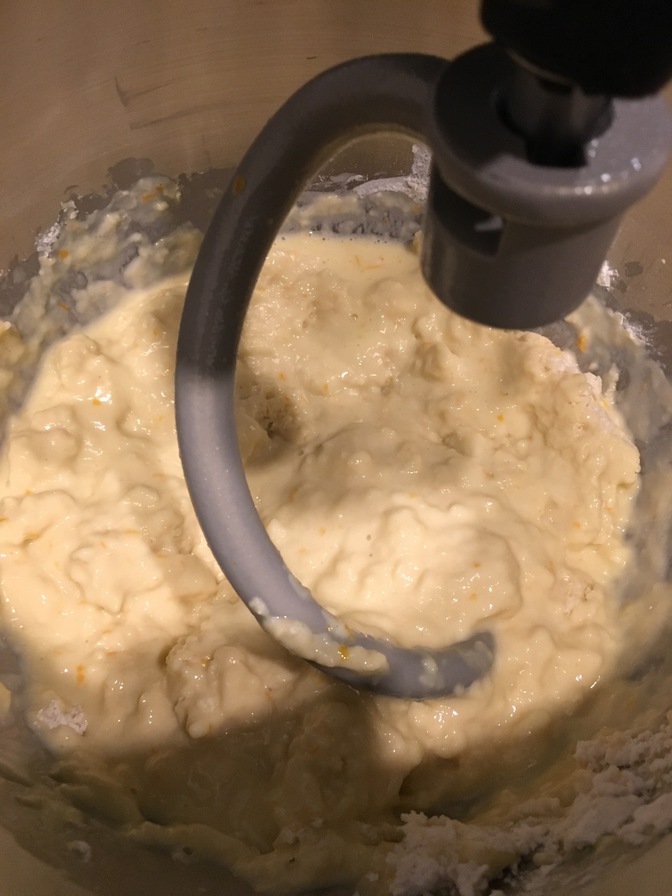
While that rested, I prepped a lot of butter.
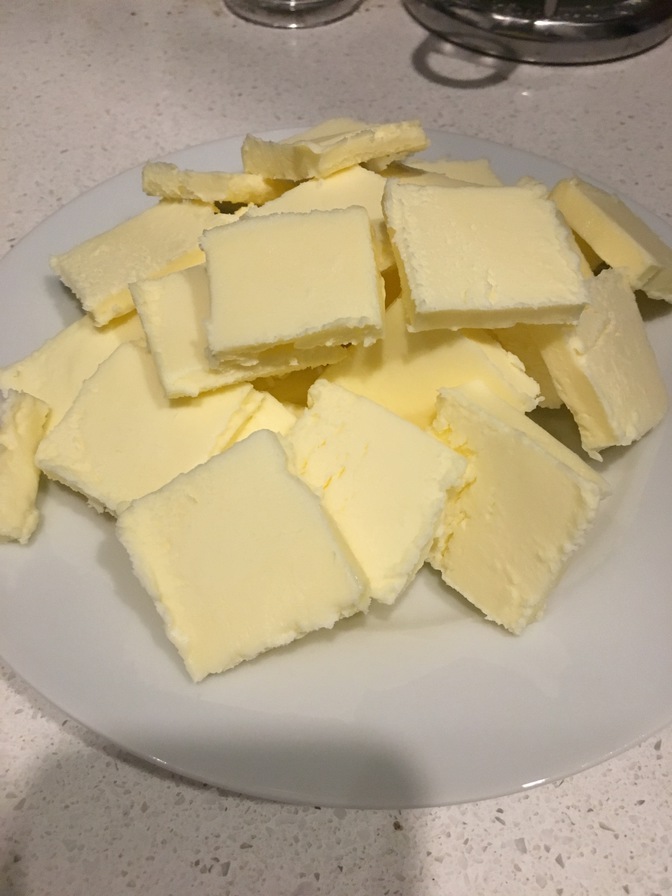
I used unsalted Plugra for this. You can use any unstaled butter you like, but I prefer a cultured butter for this since its yougurty tang works so nicely with the sourdough culture. Regardless, since butter is such a prominent flavor here, I definitely recommand spending a little money on fresh butter. It’ll make a huge difference in this application.
Once the dough had been worked a little bit and the butter had been integrated, I wound up with a beautiful enriched dough.
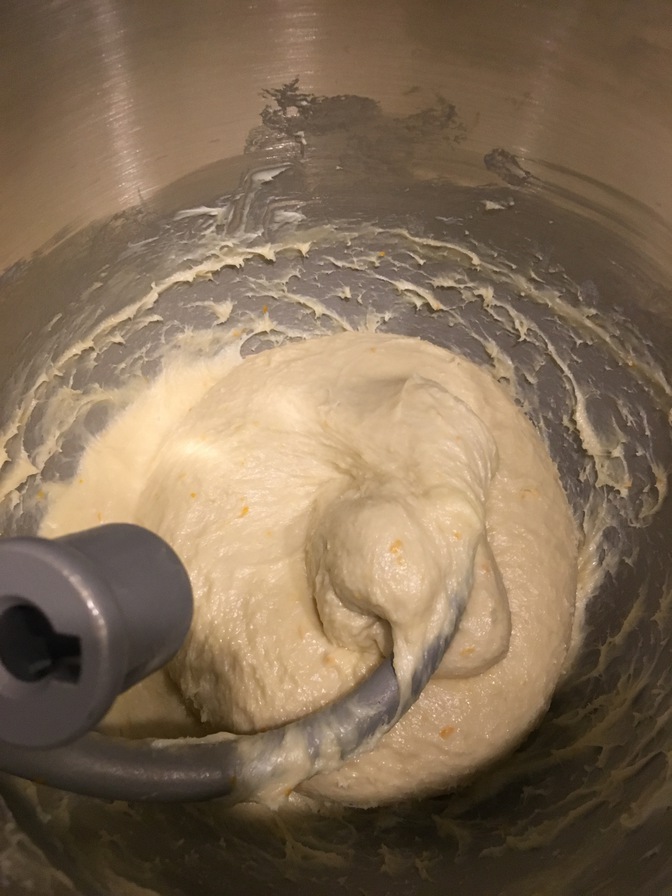
I then started in on the first fermentation, along with some stretching and folding. Around ¾ of the way through (before the 3rd set of stretches), I started working in the fruit. For my first batch, I went with dried cherries and candied peels of orange and citron, with mostly orange.
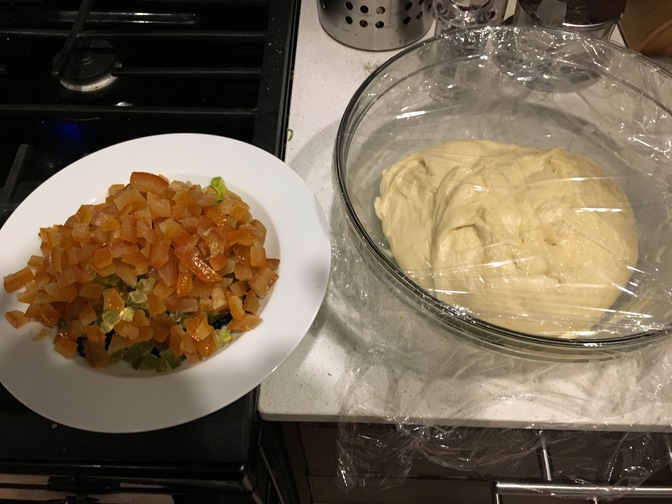
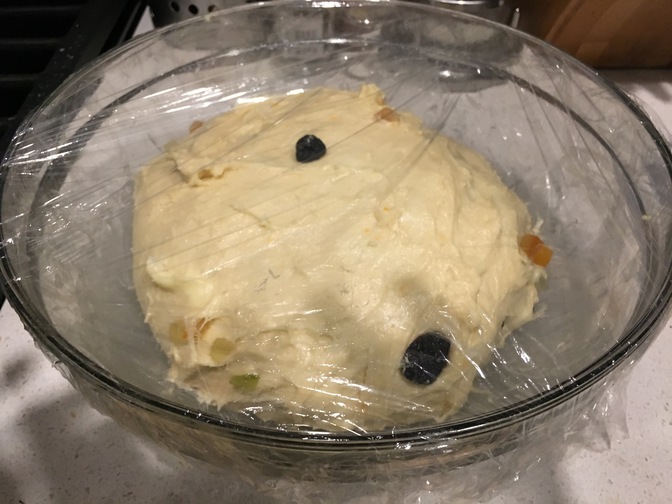
After all the manipulation, the dough went in the fridge overnight an I got to send a teasing message to the Facebook event for the movie night I was bringing the final product to.
The next morning, I removed the dough from the fridge, shaped it, and started the long final proof.
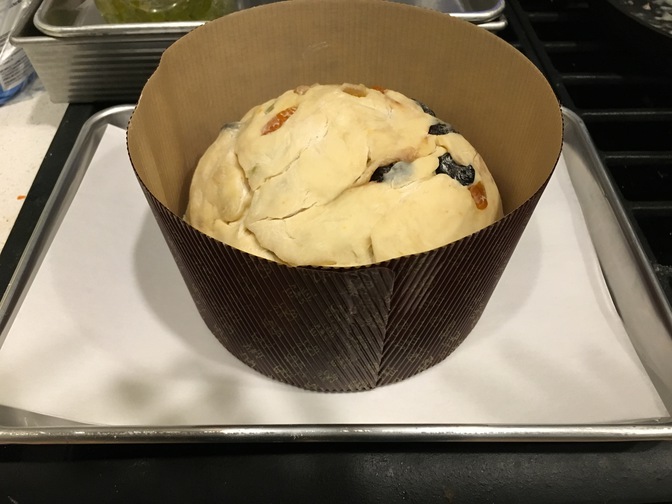
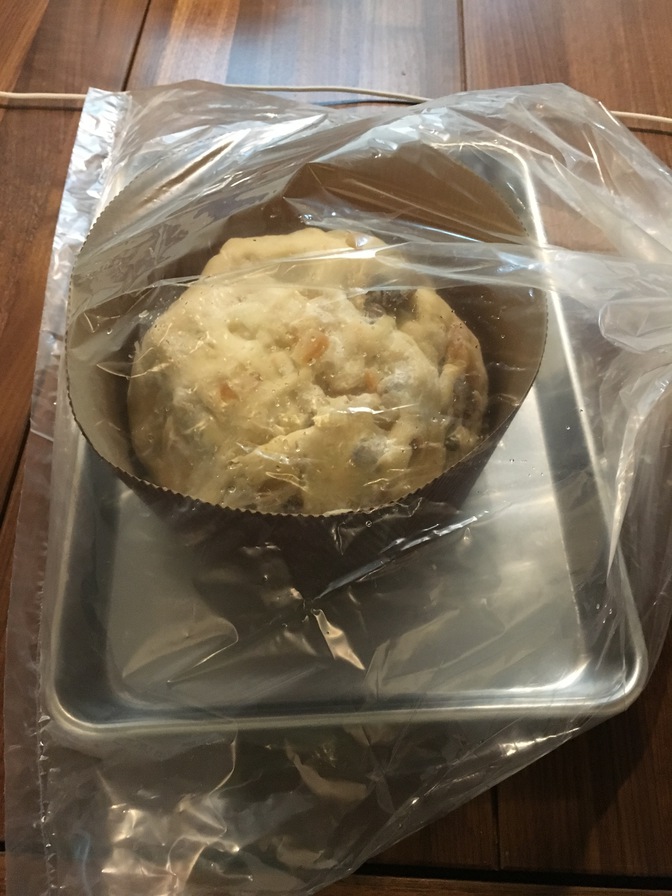
Then came the bake. Paul Hollywood said 25 minutes at 350ºF followed by 35 at 300ºF. I started with that, but found that at the end of the second segment, the top didn’t look quite done. I left it in there a bit longer, and after about an hour it was finally looking done. On a whim I stuck a thermometer into the center, and I’m super glad I did. It only registered 130ºF in the center, and enriched dough is generally not fully cooked until around 190-200ºF. I kept going, temping it every 10 or 15 minutes, until half an hour later (a total of 25 minutes at 350ºF and around 90 at 300ºF) when it finally got itself up to temp.
After a brief rest, I brought it over to my friend’s place for movie night, and we cracked it open:
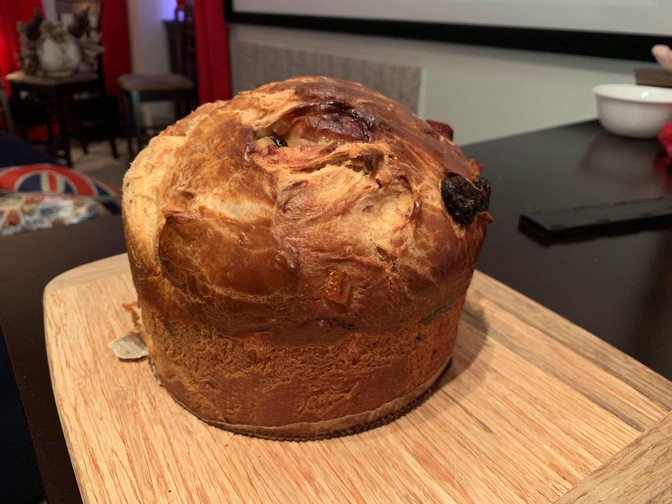
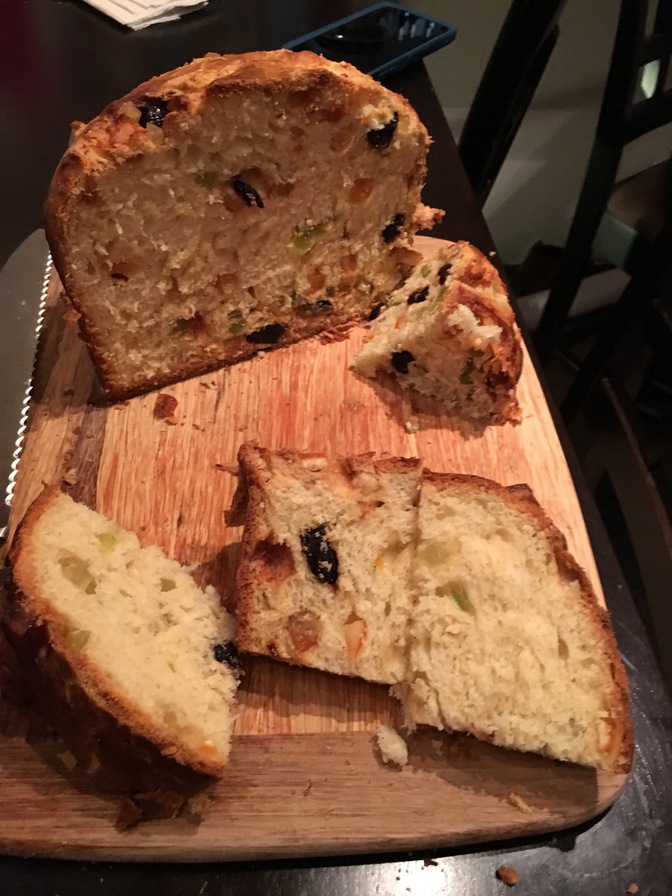
Reviews were fantastic, good enough that I felt called to make…
The Second Loaf
Okay, so the reviews were only one part of it. The other important factors were:
- I found some fig panettone in a store, which was at once mind-blowing and frustrating to me (why didn’t I think of that?).
- I already had some dried Kalamata figs at home, just waiting for inspiration to strike.
- I had a bunch of leftover orange peel and paper sleeves from the first round.
- I had a few changes I wanted to make to the recipe from the first run.
To the last point: while I think the first run was as close to an unmitigated success as I’ve ever had, I felt there was some room for improvement. The fruit distribution was uneven, and the orange flavor in the bread wasn’t as pronounced as I would have liked. So with that in mind:
- I tripled the orange zest. I might even try to add a fourth next time, but at that point we’d get into the area where I’d want to have a plan for the resulting oranges. It’s possible I need to try out some kind fo extract to strengthen the flavor even more.
- I changed the process for adding the fruit. I added the fruit and peel after the butter was integrated, before any of stretching and folding. Letting the mixer do some of the work helped tremendously in getting a more even distribution of inclusions in the bread.
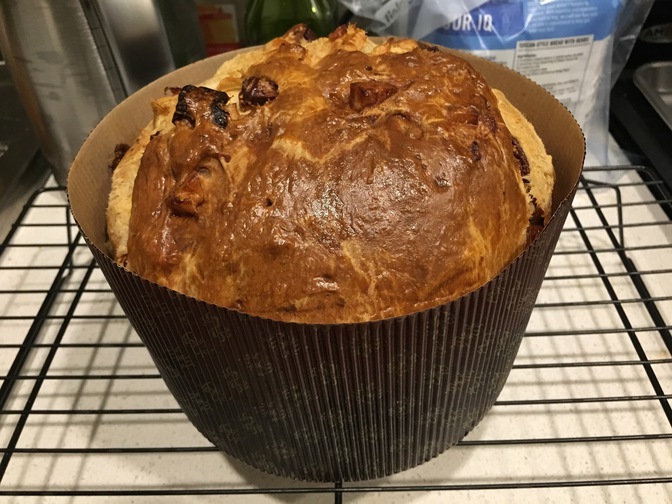
The results were a marked improvement. Orange and fig are best friends, and I think this is the flavor profile I want to focus on for future iterations.